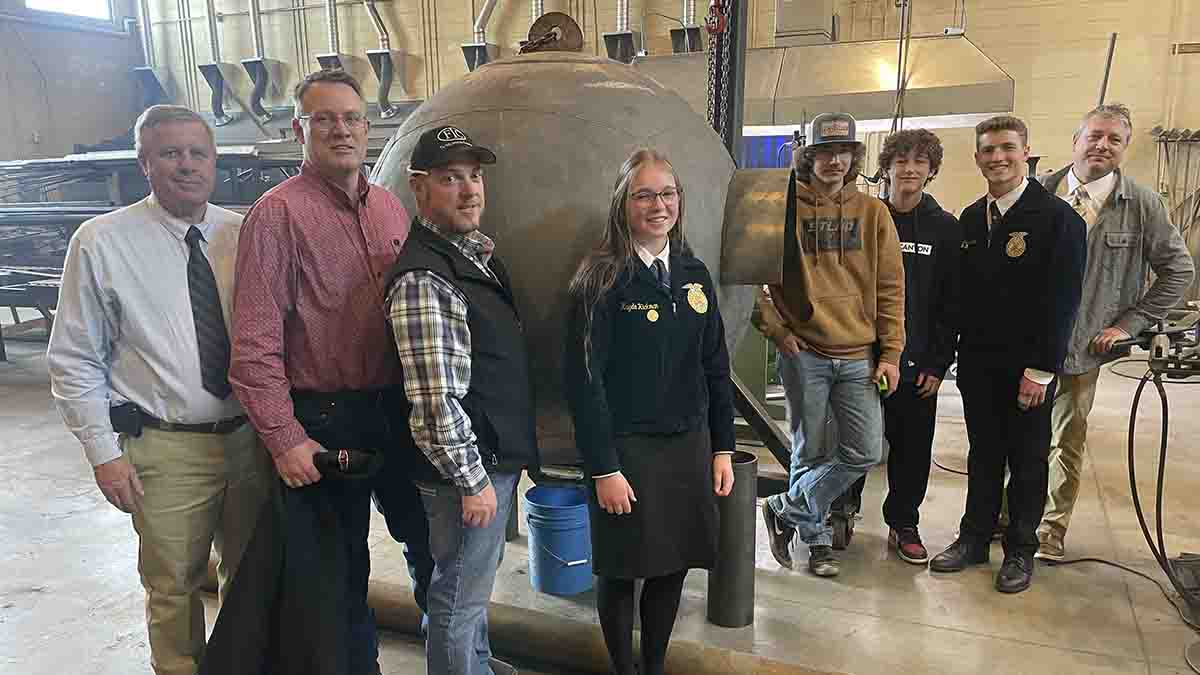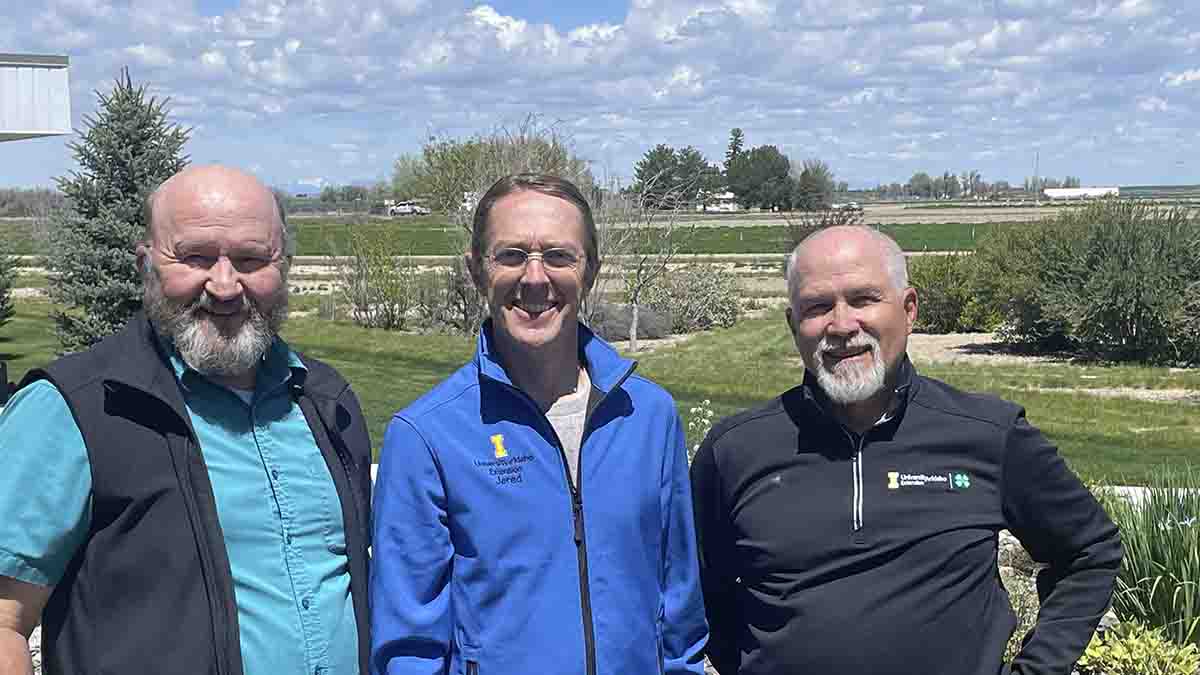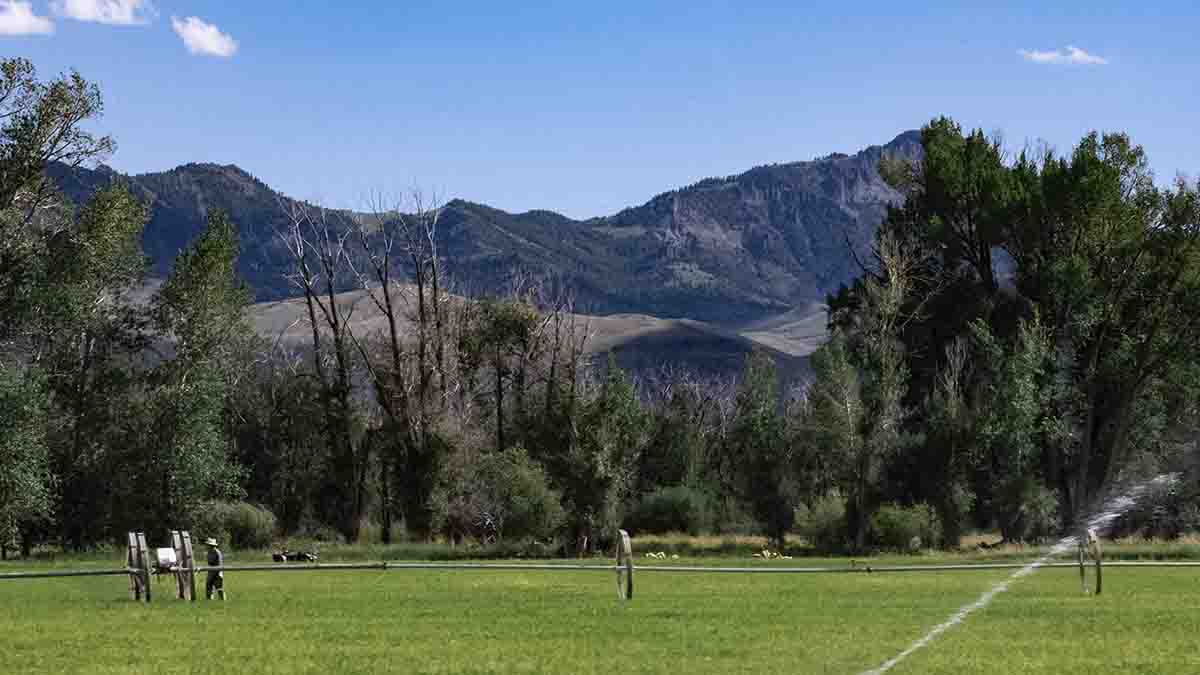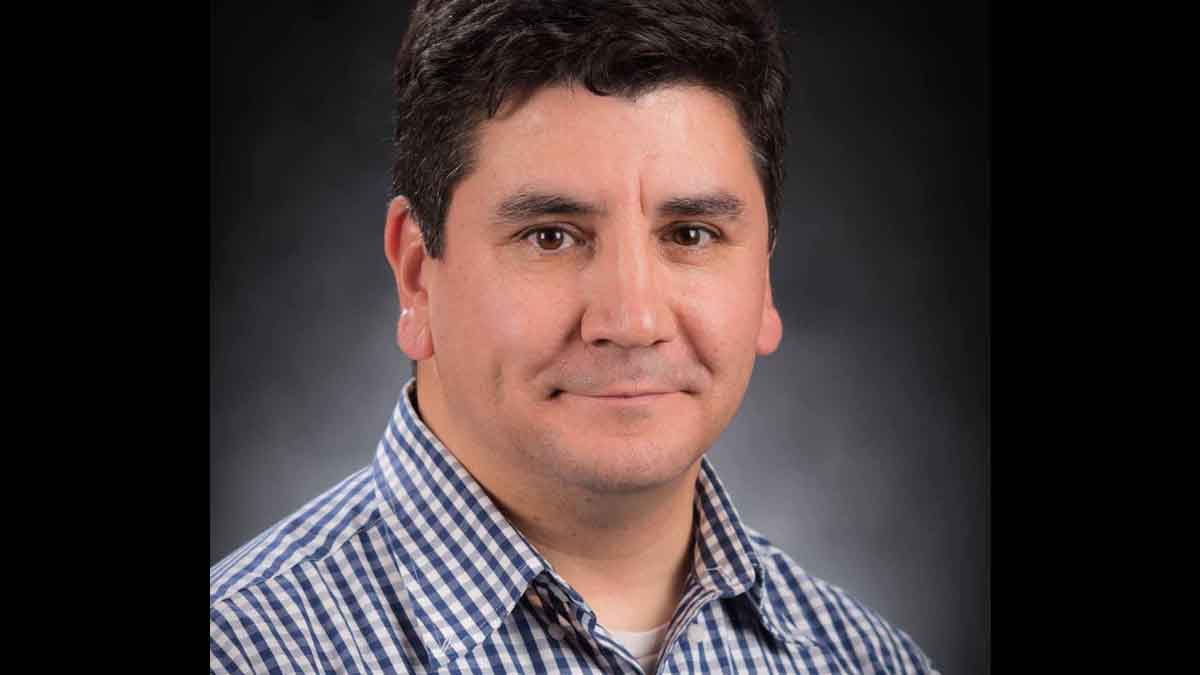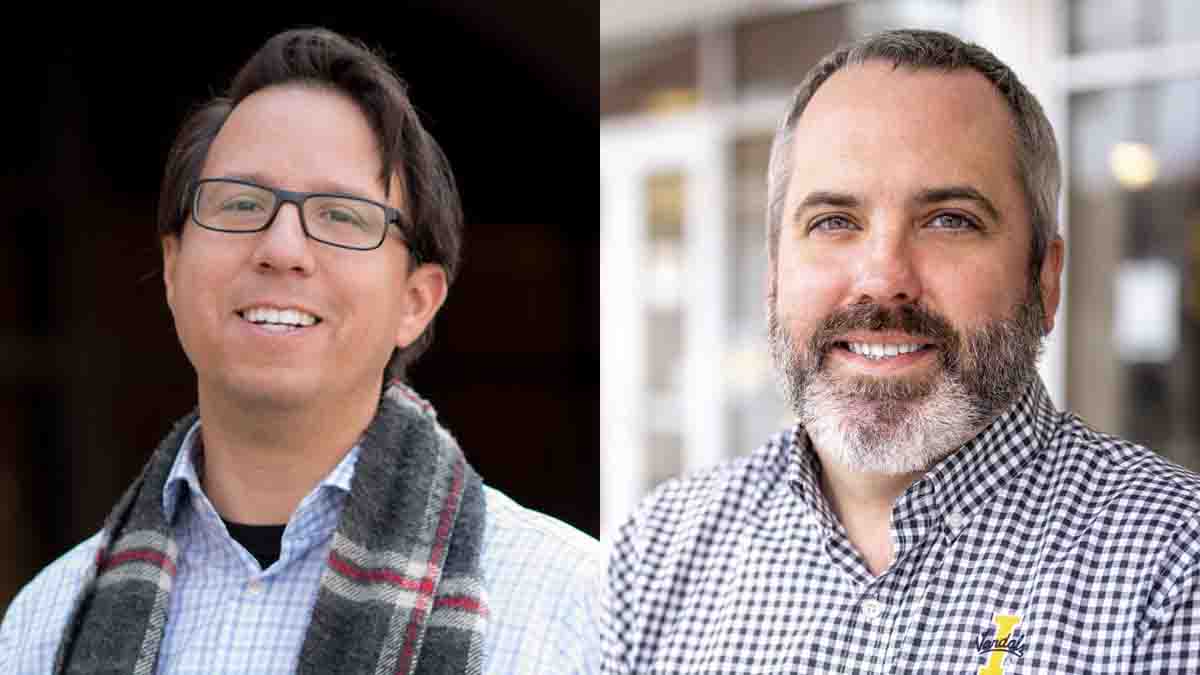Catching Up with CALS — June 26, 2024
Dean's Message — Insights from Ireland
Ireland is the ninth largest source of foreign direct investment in the U.S., with $295 billion spent in 2022. About 700 Irish firms employ more than 100,000 people in our country. One of those firms is Glanbia Nutritionals, an Ireland-based global nutrition group with Idaho locations in Twin Falls and Blackfoot and a supporter of our own Idaho Center for Agriculture, Food and the Environment (Idaho CAFE). That, plus Ireland’s focus on sustainable agricultural production, was the genesis of a recent trip to the Emerald Isle.
While in Ireland, we walked in buildings that have stood for millennia. Even the lichen-covered stone walls that crisscross the Irish landscape are ancient — some are “dry,” erected before the advent of mortar. Like its structures, Ireland's agricultural practices have withstood the test of time. As we in CALS seek to lead Idaho’s agricultural sector in adopting sustainable production practices to meet the challenges of a changing world, our team chose the perfect destination for a May 24 through June 1 trip to glean insights and inspiration.
“It’s a testament to age-old practices and how effective traditional practices can be,” said Phil Bass, an associate professor of meat science who was part of our group. “They’ve been raising agricultural goods on that ground for thousands of years. From a sustainability standpoint, it’s pretty clear.”
Irish agriculture masterfully balances the new with the old. In addition to historic production methods that remain as effective today as ever, our tour introduced us to innovative food product lines and cutting-edge science delving into sustainability and environmental stewardship. Robert Haggerty, our director of international programs, organized the trip, and Matt Powell represented our Aquaculture Research Institute (ARI).
Ireland and Idaho have much in common. Both are known for their potatoes, but dairy ranks as their top commodity — and by a wide margin. As with Idaho, Ireland exports most of its agricultural production. We witnessed the modernity of Ireland’s agricultural sector while visiting the Glanbia Nutritionals Innovation Center in County Kilkenny. The company is diversifying its line of dairy products, investing heavily in whey protein drinks and other products designed to improve nutrition and boost athletic performance. As we prepare to open Idaho CAFE in Rupert, the largest U.S. research dairy, we’re fortunate to have toured two similar research facilities that have long been operating in Ireland. University College Dublin (UCD) Lyons Farm has a 40-cow rotary parlor and catwalks enabling tour groups to see operations without getting their boots dirty. As will be the case with Idaho CAFE, sustainable agriculture and nutrient management research are hallmarks of the UCD facility, which also encompasses research in forage, beef cattle, sheep, horses, pigs and even poultry. While limiting runoff of phosphorus into waterways is a primary concern in Idaho, Ireland’s focus is on reducing nitrate pollution. The other research dairy we toured, Moorepark Animal & Grassland Research and Innovation Centre, located in County Cork, is operated by Teagasc, the state agency for agriculture, horticulture, food and rural development in Ireland. Like the U of I through our statewide delivery of research and Extension, Teagasc has a presence throughout Ireland and a heavy focus on stakeholder engagement.
Irish dairies, as well as the nation’s signature grass-fed beef industry, rely on pastures and natural rainfall. Known as swards, forage blends in Irish pastures are carefully studied and tweaked and include several rye grass cultivars, as well as clover to fix nitrogen. Irish dairies scale back milking for a few weeks of winter, when herds come off pasture and are fed baled grasses — but never corn. For all our differences, the parallels between our operations are also striking. Powell, for example, specializes in trout but uses many of the same advanced genomic techniques for breeding that the Irish scientists discussed for use in cattle.
CALS has established strong ties in Ireland — especially with UCD — through student interchanges, research collaborations and recurring trips. Amy Skibiel, an associate professor of lactation physiology, and Joe Dalton, an Extension dairy specialist, led a group of U of I students from the Department of Animal, Veterinary and Food Sciences on a trip to Ireland during the spring. Another student trip is planned for next spring. Our Department of Agricultural Education, Leadership and Communications offers a course in issues surrounding international agriculture, which prepares our students to fully appreciate such opportunities to experience agricultural operations on foreign soil. Haggerty deserves tremendous credit for building strong connections throughout the globe and organizing meaningful and memorable foreign experiences for CALS students and faculty. Haggerty’s primary emphasis has been on strengthening connections with Taiwan, Mexico, Spain and Ireland, in that order. Amin Ahmadzadeh, a professor in the Department of Animal, Veterinary and Food Sciences, has also been instrumental in establishing connections in Ireland with UCD and Teagasc since 2018. About eight CALS students per year have visited Ireland on behalf of the university since 2018, aside from a COVID-19-related hiatus. Seven CALS students have spent a semester studying in Ireland since 2017.
“It is always good to go experience how other countries are managing their agricultural systems because it helps us look at ourselves and critique ourselves compared with how others do things,” Haggerty said. “They’ve had more years of experience with it.” As our small group recently confirmed in Ireland, there’s great value in studying how others tackle common challenges, even though our circumstances may be drastically different.

Michael P. Parrella
Dean
College of Agricultural and Life Sciences
By the Numbers
The Deep Soil Ecotron, housed at the University of Idaho’s JW Martin Laboratory on the Moscow Campus, will allow researchers to study soils down to 3 meters, which is deeper than anywhere else in the world. The Ecotron will contain 24 ecounits, each covering 1 square meter of surface area. Each ecounit will hold 8 tons of soil. Each ecounit will also have 90 sensor ports with 15 measuring depths at 20-centimeter depth intervals, with 6 sensor ports per depth. Atmospheric temperature in the ecounits may be controlled to range from 39 degrees to 104 degrees, and soil temperature will range from 32 degrees to 86 degrees. The ambient atmosphere in the ecounits can be adjusted for up to 2,000 ppm of CO2, 5,000 ppb of CH4 and 1,000 ppb of N2O. Each ecounit will have an irrigation system capable of putting out 100 liters per hour. The university renovated 6,758 square feet of space to accommodate the Ecotron, also installing a 9-foot-thick concrete slab to support it. Furthermore, 1,470 linear feet of new ductwork, 4,232 linear feet of new piping, 991 new pipe fittings and 480 linear feet of new cable trays were installed. The project was funded with an $18.9 million National Science Foundation award, award No. 2131837.
Our Stories

Community Pizza Oven
A World War II-era relic converted into a wood-fired pizza oven is bringing members of a rural, eastern Idaho community together to eat, socialize and take on a difficult discussion topic — mental health.
FFA officers at Rigby High School spearheaded the effort to transform an 800-pound, steel ball used as a buoy during WWII into a massive pizza oven standing on four legs.
Rigby residents chose to build the oven as their community project for a University of Idaho Extension statewide mental health program aimed at providing aid and resources to rural Idaho communities and food producers.
Brad Schaat and Kaiden Sorensen, who were juniors in the high school’s fabrication class, collaborated on welding and construction of the attention-grabbing oven as a final project. A local fabrication shop designed and built a trailer that will haul the oven for use at various community events.
Using funding from a $200,000 Western Regional Agriculture grant, UI Extension tasked 17 small cities beginning in late 2022 with hosting a series of public discussions about the elevated risk of depression and suicide in rural America. Upon completion of those discussions, each participating city received $3,000 toward implementing a creative approach toward improving local mental health.
Signage on the trailer and oven will offer facts and resources intended to raise awareness about the serious threat of untreated mental health problems and depression in rural America.
“The hope is this becomes a focal point where people will say, ‘Hey, what the heck is that?’ and people will walk over to see it, and there will be enough information around to bring about the conversation of what this project is for,” said Lex Godfrey, the Rigby High School agricultural teacher of the fabrication class. “Food and fire bring people together.”
Inside of the oven, bricks will be laid atop a bed of sand covering a platform of concrete blended with vermiculite. The oven will have the capacity to bake about a dozen pizzas at a time in under six minutes.
UI Extension educator Lance Hansen, Madison County, who serves on the Extension farm stress management team, and Josh Tieken, who serves on the Rigby FFA advisory board, got the idea for the oven after visiting Burlington, Washington, together. They photographed another oven made from an old buoy for use in a program called Pizza for Producers.
Student FFA leaders liked the concept and began seeking donations and materials. They plan to use the oven annually during a Homecoming tailgate party. There are also plans to bring it to an area dryland farm next fall for a feast with farmers and to a local park for a community picnic. The oven will be available for farmers and local organizations to borrow for their events, as well.
“We know there are a lot of kids in our school and community who struggle with mental health issues,” said Kayda Hickman, Rigby High School FFA president. “Having an event like this at the high school and being able to bring those kids together kind of shows them they’re not alone.”
Godfrey’s father donated the buoy, which had been used domestically during WWII to hold up nets intended to keep submarines from entering the Puget Sound. Godfrey’s grandfather served in the war and brought the buoy back to the family’s dairy, where it was used for storing and hauling molasses.
For more than a month, Schaat and Sorensen worked a couple of hours on the oven every day after school. The students had to use their math skills to properly design how to attach legs to a sphere, and they’ve both been pleased by their results.
“It showed me what Kaiden and I are capable of doing with our imagination, just going off a picture,” Schaat said.
The total cost of building the trailer is estimated at $12,000 to $15,000. In addition to the initial grant funding, UI Extension is providing some additional internal funds. AgWest Farm Credit has pitched in $3,000, and the project’s leaders are soliciting additional community donors to contribute toward construction and food supplies for making pizzas.
“Even if they don’t necessarily discuss their mental health at the event, when we do serve these pizzas, just them talking to other people and seeing the issues they’re having and creating relationships, that can help them with their mental health, as well,” said Joel Ricks, FFA student advisor.
The communities that participated in the Extension mental health program have implemented a wide range of projects to improve local mental health. Residents of Eden and Hazelton applied their funding toward establishing a community center in a donated building. Wendell chose to hire bands to host music in a local park. Weiser created a pamphlet promoting local resources for those struggling with mental health or food insecurity. Several communities have also continued their public discussions about mental health.

Helping Hobby Gardeners
University of Idaho Extension Educator Ron Patterson, Bonneville County, recognizes the average Idaho gardener isn’t overly concerned about soil chemistry or the Latin names of monoecious species.
For those who wish to take such a deep dive down the gardening rabbit hole, UI Extension has long offered the Idaho Master Gardener Program, taught from a thick binder chock-full of scientific literature. Recently, however, Patterson and two of his colleagues have also dangled a carrot for the typical Eastern Idaho hobby gardener, who just wants a few basic questions answered.
From 7-8 p.m. MT on the second and fourth Tuesdays of February through October, Patterson and his Extension colleagues offer an online gardening class on a designated timely topic, called Idaho Home Garden Tips, followed by an informal question-and-answer session, called Plant Talk via Zoom. Patterson taps experts from throughout the Extension network to serve as guest presenters for the half-hour Idaho Home Garden Tips presentations. UI Extension educators Reed Findlay, Bingham and Bannock counties, and Jared Gibbons, Madison County, take turns cohosting the Plant Talk discussions with Patterson during the second half of the Zoom calls.
Attendance in the online classes varies from about 15 gardeners in the summer months, when most people would rather be outdoors than online, to upwards of 50 participants in the winter and early spring. Advanced Idaho Master Gardeners may earn continuing education credits through their participation, but Patterson’s goal is to get more rank-and-file gardeners to participate in the calls.
“I wanted to have a little more public educational opportunities and not just the master gardeners because that’s a pretty select group,” Patterson said. “We have a lot of people who just want to garden, and they have little issues. The whole point is to get information to the general public.”
Patterson began hosting Zoom-based bimonthly roundtable discussions for his master gardeners in 2020 and began opening them up to gardeners from outside of the program. In 2021, Patterson and Findlay launched Plant Talk together, patterning the program on the popular NPR radio auto mechanics program Car Talk. They field participants’ questions and end each program by challenging participants to try to stump them with a particularly hard gardening question.
“We don’t disagree; we just come at it from a different point of view,” Findlay said. “We’re always able to come to a research-based consensus at the end.”
Gibbons filled in when Findlay had other responsibilities that interfered with regular participation and has continued periodically substituting for Findlay as a co-host ever since.
“I think it’s a great way to reach people with digital methods because they don’t always have time to come to a regular class,” Gibbons said. “There may be a particular topic they’re dealing with in their yard, so they’re going to come on for the call when it comes up.”
A little more than a year ago, the group combined Idaho Home Garden Tips and Plant Talk into a single Zoom call. They promote the combined program through their Pest Alert Newsletters and by word of mouth when people contact their offices with gardening questions. They plan to make a push this gardening season to boost awareness of the program, recruiting both participants and UI Extension experts to present on areas of expertise from all corners of the state.
In addition to fielding questions during the calls, they often address recurring gardening issues that stakeholders bring to their attention.
“Where we’re answering the same questions multiple times, if we can handle everybody at once we can save some time,” Gibbons said.
Popular question topics recently have included weeds, plant diseases, greenhouses, drip irrigation and organic pest control methods. Many people have also inquired about some mysterious recent tree deaths in the region. In many cases, Patterson suspects the deathblow was dealt during an extreme cold spell in the winter of 2022-2023, and the trees have been slow to show symptoms of their decline.
Several other resources are available to gardeners in eastern Idaho through the UI Extension office in Bonneville County. Gardeners may register for a weekly Pest Alert Newsletter. Several general gardening videos featuring Patterson are available on YouTube. Furthermore, master gardeners are typically available to answer gardening questions during diagnostics clinics hosted from 9 a.m. to 5 p.m. on Tuesdays and Thursdays from mid-May through mid-September at the UI Extension office in Bonneville County, 1542 E. 73rd S., Idaho Falls. Gardeners may also call the office at 208-529-1390 with questions.
“In eastern Idaho, gardening is a way of life. It’s a self-sufficiency kind of culture,” Patterson said. “Now there is a big interest in the younger generation in gardening. Where do they go for their information? They go online and they watch videos, and some of that stuff that’s online is just not accurate.”

Tool Tracks Evapotranspiration
The Idaho Department of Water Resources (IDWR) is partnering with the University of Idaho to test the accuracy of a new automated tool that interprets satellite imagery to help farmers and water managers track daily crop water consumption.
The cloud-based tool, called OpenET, takes thermal imagery from NASA Landsat satellites and maps daily and cumulative evapotranspiration over the growing season, allowing users to zoom in and study variability within individual pivots.
IDWR has awarded U of I agricultural engineering Professor Erin Brooks, within the Department of Soil and Water Systems (SWS), roughly $800,000 over three years to test and calibrate OpenET, which provides users data quickly and conveniently and is also accessible to aid growers in water management decisions. Meetpal Kukal, who will join SWS in August as a new professor specializing in hydrologic science and water management, and Jason Kelley, a former U of I professor in the same department, will be coinvestigators.
IDWR has been using METRIC — software developed by Richard Allen, a former U of I professor in SWS, and requiring trained staff to manually run imagery to produce evapotranspiration data. Allen also aided in the development of the beta version of OpenET before retiring in 2022.
Tracking evapotranspiration will inform growers of the amount of water their crops are using compared with the amount they’re applying to their fields through irrigation equipment, helping them improve efficiency.
“It helps growers in the sense that they can actually go in and see what happened, and they can actually evaluate their water-use efficiency — something they’ve never been able to do before on a field-by-field basis, and it helps IDWR know what has gone on and whether curtailments have made a difference,” Brooks said.
This fall, the U of I team will place soil moisture sensors and eddy covariance towers by three Magic Valley fields to record baseline evapotranspiration data. The towers take a host of ground-based, site-specific meteorological readings,. They also plan to include data for this analysis from a pair of eddy covariance towers in use for a separate project on farm fields at the future site of U of I’s Idaho Center for Agriculture Food and the Environment (Idaho CAFE) in Jerome. The team will compare the data with rates OpenET provides from the same sites to determine what, if any, adjustments are needed to improve the automated tool’s performance.
“Initial testing of OpenET by IDWR suggests there may be some errors introduced in the automated approach,” Brooks said. “They are interested in evaluating the accuracy of this new tool and potentially developing approaches to correct any errors that may be revealed by the project.”
Under Idaho law, water rights are tied to the amount of water farmers divert from rivers or withdraw from the aquifer by pumping. However, much of the water is not taken up by plant roots, seeps back into an aquifer or is left unused and returns to rivers in canals. As a result, farmers may divert less water without affecting their true consumption, thereby improving their own efficiency without affecting minimum flows required by Idaho Power to provide sufficient hydroelectric power to the state.
“Accurate quantification of evapotranspiration from irrigated lands is critical to basin-scale water budgets and sustainable water management in Idaho,” said Phil Blankenau, an IDWR evapotranspiration analyst.
Producers have relied upon AgriMet weather station data as a guide to predict the potential amount of irrigated water that could be consumed by crops under optimal soil conditions, but the actual amount of consumed water could vary based on the irrigation that actually occurred, the actual soil type, crop type and the fertility of the soil within any field.
“If we don’t see a difference in evapotranspiration after a curtailment in an area that means the growers are more efficient with how they use the water, and it ultimately doesn’t help maintain the minimum flows the Snake River as required by Idaho Power to meet state power demands,” Brooks said. “By becoming more efficient it’s not solving any of our water problems in the end. That consumptive water use has to go down in order to have more water at the outlet.”
Faces and Places
Hernan Tejeda, a University of Idaho Extension agricultural economist, will be featured in a panel discussion about factors driving current dairy markets during the International Farm Comparison Network Dairy Conference, scheduled for June 29 through July 2 in Obihiro, Japan. The theme of the conference will be “West Meets East; Asian Dairies Standing Locally, Thinking Globally.”
UI Extension Area Educator Maureen Toomey is retiring June 28 after more than 34 years of service. Maureen has served as PI or co-PI on several programs, including 4-H Healthy Habits, Well Connected Communities, 4-H Create Art Now, Farm to Early Childcare Education and 4-H Teen Health Advocates.
Ginny Lane, an assistant professor in the Margaret Ritchie School of Family and Consumer Sciences (FCS), will present research goals of her project for University of Idaho’s new Center for Biomedical Research Excellence (COBRE). Lane focuses on community and global nutrition, food security risks among vulnerable populations, international and indigenous contexts, determinants of chronic disease and multidisciplinary mixed methods approaches to complex issues. Her presentation is scheduled for noon to 1 p.m. July 8 at the Seed Potato Germplasm Laboratory, 753 Perimeter Drive, Moscow. Lunch will be served, and the presentation will also be available on Zoom. Please RSVP by today at angels@uidaho.edu or 208-885-1502. Shelley McGuire, professor of nutrition and director of FCS, recently received an $11 million grant through the National Institutes of Health to start the biomedical research center, which will focus on furthering studies on women’s health and nutrition.
The first Deep Soil Ecotron (Facebook) unit has arrived at the JML lab in Moscow. The Deep Soil Ecotron is a first-of-its-kind facility that will explore unstudied communities of deep soil. The project is funded by a National Science Foundation grant. Zachary Kayler and Michael Strickland, faculty within the Department of Soil and Water Systems, are co-directors of the Ecotron project.




Events
- June 24-27 — Idaho 4-H State Teen Association Convention, Moscow
- June 27 — Idaho Veterans & NRCS/Accessing Available Cost Share Programs, Technical Assistance & More to Help You Find Success webinar, online
- June 28 — State 4-H Dairy Judging Contest, Nampa
- July 8-10 — Beef 101: Beginning Rancher Development Program, Moscow
- July 9 — Ag Talk Tuesday, online
- July 10 — Bellevue Sulfur Fertility Trials Field Day, Bellevue
- July 17 — Twilight Tour, Aberdeen Research and Extension Center







